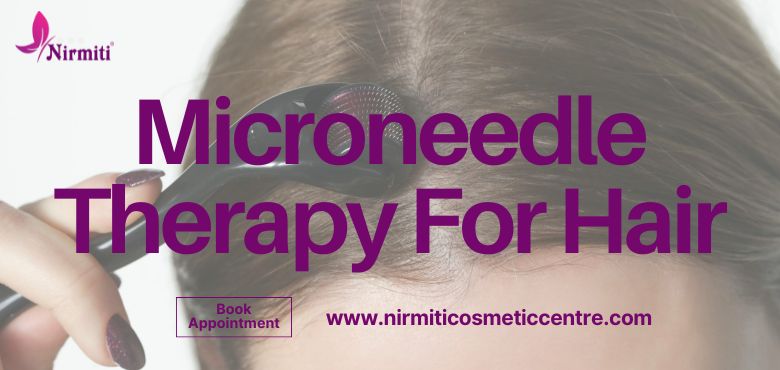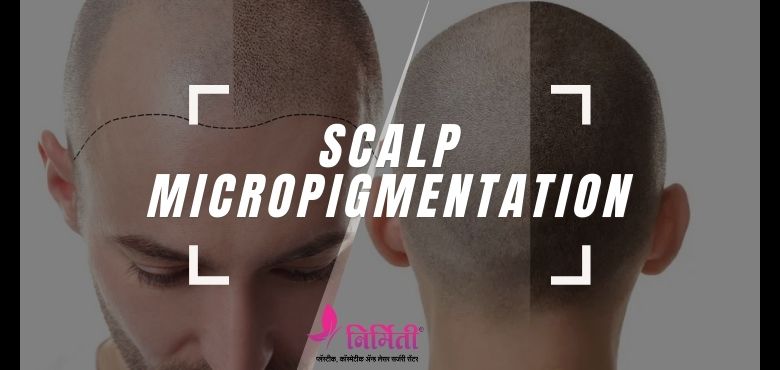Scalp Micropigmentation vs. Hair Transplants: Which One Is Right for You?
Hair loss is a common concern that affects millions of people worldwide. While the emotional toll of thinning hair can be significant, the good news is that there are effective treatments available. Two of the most popular options for restoring hair appearance are Scalp Micropigmentation (SMP) and Hair Transplants. Each of these methods offers distinct advantages, and the choice between them depends on various factors such as the extent of hair loss, budget, and desired results.
In this post, we’ll break down both treatments to help you make an informed decision about which is best for you. Whether you’re considering a microneedle therapy for hair or a surgical hair transplant, we’ll cover everything you need to know about these treatments at Nirmiti Cosmetic Centre, led by the experienced Dr. Neeraj Bhaban.

In This Article:
What Is Scalp Micropigmentation (SMP)?
Scalp Micropigmentation is a non-surgical procedure that involves the application of tiny pigment deposits into the scalp using a specialized microneedling technique. This creates the illusion of a fuller head of hair by replicating the natural appearance of hair follicles.
During the procedure, a trained technician uses a microneedle therapy for hair to insert pigment into the scalp. This process mimics the look of a closely shaved hairline, enhancing the appearance of density in areas of thinning or bald spots. The results are highly realistic, and SMP can work for both men and women suffering from hair thinning or complete hair loss.
Benefits of Scalp Micropigmentation:
- Non-invasive: No surgery, stitches, or downtime.
- Quick results: Typically completed in 2-3 sessions.
- Cost-effective: Generally more affordable than hair transplants.
- Low maintenance: Once healed, it requires minimal care.
- Versatility: Suitable for all stages of hair loss and can even be used to complement a hair transplant for more density.
What Is a Hair Transplant?
A Hair Transplant is a surgical procedure where healthy hair follicles from one part of your scalp (often the back or sides) are removed and transplanted to areas experiencing hair loss. This procedure can either be done using Follicular Unit Transplantation (FUT) or Follicular Unit Extraction (FUE), two of the most popular techniques.
- FUT: A strip of scalp skin is removed, and hair follicles are dissected and transplanted into thinning areas.
- FUE: Individual hair follicles are extracted and transplanted one by one, leaving no linear scar.
Hair transplant surgery typically requires a longer recovery time, with some redness and scabbing expected after the procedure. It is usually performed under local anesthesia and can take several hours, depending on the extent of the procedure.
Benefits of Hair Transplants:
- Permanent results: Transplanted hair follicles are permanent and continue to grow naturally.
- Natural look: Since your own hair is used, the results tend to look natural.
- Can restore a full hairline: Hair transplants are suitable for those with significant hair loss and can restore an entire hairline.
Scalp Micropigmentation vs. Hair Transplants: Which One Should You Choose?
Choosing between Scalp Micropigmentation and a Hair Transplant depends on several factors. Below, we compare these two methods to help you understand which treatment may be the best fit for your needs.
- Extent of Hair Loss
If you’re experiencing minor thinning or early stages of hair loss, Scalp Micropigmentation may be the ideal solution. It can provide an instant and natural-looking improvement without the need for surgery. SMP is particularly effective for individuals with diffuse thinning, bald spots, or those who want to improve the appearance of a receding hairline.
On the other hand, if you have significant hair loss, particularly in the crown or top of your head, a Hair Transplant might be the better option. It’s the go-to treatment for restoring full hair density and can address areas where SMP may not provide sufficient coverage.
- Permanent vs. Temporary Results
A key difference between SMP and Hair Transplants is the longevity of results. Hair Transplants offer permanent results, with transplanted hair growing naturally over time. Once the hair follicles are transplanted, they’re resistant to further hair loss.
However, Scalp Micropigmentation is a semi-permanent solution. The pigments used in SMP fade over time and require touch-ups every 3-5 years, depending on factors such as skin type, lifestyle, and aftercare. For those seeking long-term results without the need for future treatments, a hair transplant might be the better choice.
- Cost
Scalp Micropigmentation is generally much more affordable than Hair Transplants. The cost of SMP depends on the area of the scalp being treated and the number of sessions required, but it is usually significantly less expensive than hair transplant surgery, which can run into the thousands of dollars.
For individuals on a budget or those seeking a non-surgical option, Scalp Micropigmentation offers a cost-effective way to address hair loss without breaking the bank. However, if you’re looking for permanent results and have a higher budget, a hair transplant could be worth the investment.
- Procedure Time and Recovery
One of the biggest advantages of Scalp Micropigmentation is its minimal downtime. The procedure typically requires only a few sessions, each lasting 2-4 hours, and recovery is quick. Most clients can return to work and daily activities immediately after the procedure with no significant discomfort.
In contrast, Hair Transplants require more recovery time, with some redness, swelling, and scabbing occurring post-surgery. While the procedure itself can take several hours, the recovery time may extend up to several weeks for full healing, and you’ll need to avoid strenuous physical activities during this time.
- Naturalness of Results
Both Scalp Micropigmentation and Hair Transplants can deliver natural-looking results, but the approaches are different. A Hair Transplant uses your natural hair, so the results blend seamlessly with the rest of your hair. However, depending on factors like the quality of the donor hair and the skill of the surgeon, results can vary.
Scalp Micropigmentation, on the other hand, doesn’t involve hair growth but creates a realistic illusion of fuller hair. The key to a natural look with SMP is choosing an experienced practitioner, such as those at Nirmiti Cosmetic Centre, led by Dr. Neeraj Bhaban. The microneedle therapy for hair is designed to mimic natural hair follicles, making the results indistinguishable from a real hairline when done correctly.
Which One Is Right for You?
Ultimately, the decision between Scalp Micropigmentation and Hair Transplants depends on your specific goals, the extent of hair loss, budget, and preference for a non-surgical versus surgical solution. Here’s a quick guide to help you decide:
- Choose Scalp Micropigmentation if you want a non-invasive, quick, and cost-effective solution for thinning hair or bald spots.
- Choose a Hair Transplant if you are seeking a permanent, natural solution to significant hair loss and are willing to undergo a surgical procedure.
At Nirmiti Cosmetic Centre, led by Dr. Neeraj Bhaban, you can explore both options with expert consultation and guidance. Dr. Bhaban’s team is highly skilled in microneedle therapy for hair and hair transplant techniques, ensuring that you receive the best possible treatment based on your unique needs.
Conclusion
Both Scalp Micropigmentation and Hair Transplants offer effective solutions for hair loss, but the right choice depends on your individual needs and circumstances. If you’re looking for a quick, non-invasive solution with immediate results, SMP might be the right option for you. If you prefer a more permanent solution and are prepared for the surgical process, a hair transplant may provide the lasting results you desire.
No matter which treatment you choose, it’s crucial to consult with a qualified expert to ensure the best outcome. Nirmiti Cosmetic Centre, led by Dr. Neeraj Bhaban, offers comprehensive consultations and treatments that will guide you to the perfect solution for your hair restoration journey.






